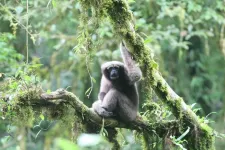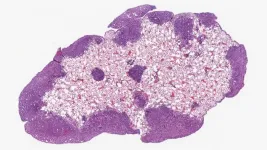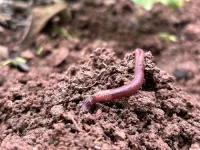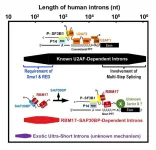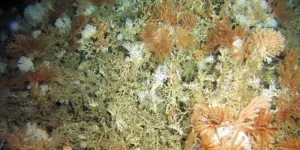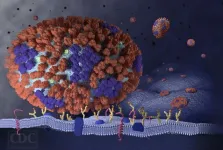(Press-News.org) Skywalker gibbon couples wake up each morning and sing to each other, their voices echoing across the forest canopy of their home. The primate’s endearing love song helped scientists confirm what was formerly a strong hunch: Myanmar has the largest population of endangered Skywalker gibbons on Earth.
When Star Wars-loving scientists identified Skywalker gibbons as a distinct species in 2017, fewer than 200 individuals were known to exist, all in southwestern China. A study published today in the International Journal of Primatology is the first in the past century to confirm living Skywalker gibbons in Myanmar.
The study was led by the Karen C. Drayer Wildlife Health Center at the University of California, Davis, which facilitated the formation of the Myanmar Skywalker Gibbon Conservation Committee. Led by Myanmar investigators and composed of Myanmar non-governmental organizations, the group was tasked with leading these important discoveries in their country. Field expeditions were conducted by partner organizations, including Nature Conservation Society Myanmar and Fauna & Flora International – Myanmar.
“We were able to genetically identify 44 new groups of Skywalker gibbons in Myanmar,” said senior author Tierra Smiley Evans, research faculty with the One Health Institute in the UC Davis School of Veterinary Medicine. “This is a huge resource and success story for Myanmar.”
Exact numbers of individuals are unknown, but Skywalkers were identified in areas previously thought to be occupied by the Eastern hoolock gibbon. Population estimates from 2013 suggested that there could have been up to 65,000 gibbons in the area where Skywalkers have now been identified, making this the largest probable population of Skywalker gibbons in one place.
Scientists suspect today’s actual numbers are lower given ongoing hunting, limited protected areas and political unrest in Myanmar.
Love songs and chewed plants
Like their Jedi namesake, Skywalker gibbons cannot swim, so rivers tend to demarcate their species boundaries. This led scientists to think Skywalkers likely extended into Myanmar between two rivers to the west and another to the east, but their theory remained unconfirmed until this study.
Safety concerns related to civil and ethnic unrest, on top of a global pandemic, have limited primate surveys in Myanmar, especially by foreign scientists. Smiley Evans said the study was possible only through the efforts of the Myanmar field research team.
Between December 2021 and March 2023, the field team in Myanmar set up acoustic monitoring systems, listening each morning for the Skywalker gibbons’ love songs, recording their solos and duets, their start and end times.
Using a noninvasive DNA sampling technique created by Smiley Evans, they then collected chewed plants and fruits from the gibbons. Genetic analysis of these samples confirmed the species.
The team examined photographs for characteristics that distinguish between Skywalker hoolock gibbons and other hoolock species. These include thinner eyebrows, a black or brown beard instead of a white one, and incomplete white face rings on the females.
They also conducted threat assessment surveys in 12 villages to gather local knowledge about gibbons and the threats they face.
“Biologists did not believe Skywalker gibbons could live in the small remaining patches in Southern Shan State before we started this project,” said Pyae Phyo Aung, executive director of Nature Conservation Society Myanmar. “I am delighted with our field team members who have done an excellent job, within a short period of time, building community trust for further conservation actions. This area is degraded forest. It is really important for Myanmar and China to consider extending conservation approaches for the Skywalker gibbon to this new geographic area.”
Red List guidance
The findings will help guide updates for the International Union for the Conservation of Nature’s (IUCN) Red List of Threatened Species.
While the findings raise the population estimates of Skywalker gibbons, ongoing habitat loss, degradation and human conflict in Myanmar continue to threaten the species, most of which live outside protected areas.
For those reasons, the authors suggest the species retain its Endangered designation on the IUCN Red List and that its habitat in Myanmar be considered for protected area status.
“We found Skywalker gibbons in two regions of Myanmar: Kachin state and as far south as Shan state, in degraded forests and at much lower elevations than we expected, showing us they’re highly adaptable,” Evans said. “There needs to be a protected area system there that focuses on them.”
This study was a team effort with co-authors from the University College London, Zoological Society of London, German Primate Center, Livestock Breeding and Veterinary Department Myanmar, Myanmar Timber Enterprise, California National Primate Research Center, Sun Yat-Sen University and the IUCN Species Survival Commission (SSC) Primate Specialist Group Section on Small Apes.
The study was funded by Arcus Foundation, the IUCN SSC Primate Specialist Group Section on Small Apes, National Science Foundation and the International Centre for Integrated Mountain Development.
END
Love songs lead scientists to new populations of skywalker gibbons in Myanmar
The endangered primate’s love songs alerted scientists to their home beyond China
2024-02-14
ELSE PRESS RELEASES FROM THIS DATE:
Case study: drug-resistant bacteria responds to phage-antibiotic combo therapy
2024-02-14
PITTSBURGH, Feb. 14, 2024 – It was a last-ditch effort. For years doctors had tried to keep a patient’s recurrent drug-resistant bacterial blood infection at bay, but it kept coming back and antibiotics were no longer working.
The family agreed to try an experimental treatment that uses viruses to kill bacteria. The patient’s Enterococcus faecium bacterial strain, which had become zombie-like and was almost impossible to treat with currently available antibiotics, was tested against wastewater collected from across the country to find a virus – called a bacteriophage – that scientists theorized would specifically target the drug-resistant bacteria.
It worked ...
ETRI unveils AI analysis service platform at international e-sports tournament
2024-02-14
ETRI’s researchers have developed an AI-powered e-sports analysis platform that provides real-time win rate prediction services by analyzing gameplay screens. This platform was notably applied to the highly popular League of Legends (LoL) during a recent international e-sports tournament, garnering positive feedback.
Electronics and Telecommunications Research Institute (ETRI) has developed a technology that recognizes real-time game situations by analyzing play elements extracted from game videos and automatically generates highlights by identifying key play events in the game.
Also, this e-sports service platform, based ...
Pancreatic cancer hijacks a brain-building protein
2024-02-14
Scientists at Cold Spring Harbor Laboratory (CSHL) and the University of California, Davis have reached a new breakthrough in pancreatic cancer research—eight years in the making. It could help slow the disease’s deadly spread.
In 2017, as a postdoc in CSHL’s Tuveson lab, Chang-il Hwang and collaborators from the Vakoc lab uncovered a protein essential for jumpstarting metastasis in pancreatic ductal adenocarcinoma (PDAC). Now an assistant professor at UC Davis, Hwang recently reunited with CSHL Professors David Tuveson and Christopher Vakoc. The trio once again set their sights on PDAC. The disease is known for its aggressiveness. ...
Pesticides to help protect seeds can adversely affect earthworms’ health
2024-02-14
While pesticides protect crops from hungry animals, pesky insects, or even microbial infections, they also impact other vital organisms, including bees and earthworms. And today, research published in ACS’ Environmental Science & Technology Letters reveals that worms are affected by the relatively small amounts of chemicals that can leach out of pesticide-treated seeds. Exposure to nonlethal amounts of these insecticides and fungicides resulted in poor weight gain and mitochondrial DNA (mtDNA) damage in the worms.
Pesticide treatment can be introduced at several different ...
Discovery of a subset of human short introns that are spliced out by a novel mechanism
2024-02-14
In humans, the length of pre-mRNA varies extensively (from 30 to 1,160,411 nucleotides by recent studies). The fundamental mechanism of splicing has been studied with model pre-mRNAs including 158- and 231-nt introns, for historical instance, that are spliced very efficiently in vitro and in vivo. Such an ideal pre-mRNA contains good splicing signal sequences, i.e., the 5′ splice site, the branch-site (BS) sequence, and the polypyrimidine tract (PPT) followed by the 3′ splice site that are recognized by U1 snRNP, U2 snRNP and U2AF2–U2AF1, respectively. Prof. Mayeda says, “Given the diverse lengths ...
Cold-water coral traps itself on mountains in the deep sea
2024-02-14
Corals searching for food in the cold and dark waters of the deep sea are building higher and higher mountains to get closer to the source of their food. But in doing so, they may find themselves trapped when the climate changes. That is shown in the thesis that theoretical ecologist Anna van der Kaaden of NIOZ in Yerseke and the Copernicus Institute for Sustainable Development in Utrecht will defend on Feb. 20 at the University of Groningen. “When the water gets warmer, these creatures prefer to be deeper, but a coral doesn’t just walk down the mountain,” Van der Kaaden said.
Deep and dark
Unlike the famous, colorful tropical corals, cold-water corals live ...
Cost-effective to routinely change surgical gloves and instruments as well as being safer
2024-02-14
Surgeons who routinely change surgical gloves and instruments are incurring similar costs to those using the same equipment, a new study has found.
The economic evaluation funded by the UK’s National Institute for Health and Care Research (NIHR) follows a clinical trial conducted at 80 hospitals in Benin, Ghana, India, Mexico, Nigeria, Rwanda, and South Africa which established that routine change of gloves and instruments reduces surgical site infections (SSIs) by 13%.
The evaluation, published by the Lancet Global ...
Scientists discover hidden army of lung flu fighters
2024-02-14
Scientists have long thought of the fluid-filled sac around our lungs merely as a cushion from external damage. Turns out, it also houses potent virus-eating cells that rush into the lungs during flu infections.
Not to be confused with phages, which are viruses that infect bacteria, these cells are macrophages, immune cells produced in the body.
“The name macrophage means ‘big eater.’ They gobble up bacteria, viruses, cancer cells, and dying cells. Really, anything that looks foreign, they take it up and destroy it,” said UC Riverside virologist Juliet Morrison, who led the discovery team. “We were surprised to find them in the lungs ...
USC announces new Leonard D. Schaeffer Institute for Public Policy & Government Service
2024-02-14
USC, together with Leonard and his late wife Pamela Schaeffer, is launching a new institute with a $59 million gift from the Schaeffers to be anchored in Los Angeles and in the university’s new Capital Campus in Washington, D.C. The mission of the Leonard D. Schaeffer Institute for Public Policy & Government Service is to strengthen democracy by training generations of public leaders and advancing evidence-based research to shape policy that addresses the nation’s most pressing issues, USC President Carol Folt announced ...
Nearly 15% of Americans deny climate change is real, AI study finds
2024-02-14
ANN ARBOR—Using social media data and artificial intelligence in a comprehensive national assessment, a new University of Michigan study reveals that nearly 15% of Americans deny that climate change is real.
Scientists have long warned that a warming climate will cause communities around the globe to face increasing risks due to unprecedented levels of flooding, wildfires, heat stress, sea-level rise and more. Though the science is sound—even showing that human-induced, climate-related natural disasters are growing in frequency ...
LAST 30 PRESS RELEASES:
Making lighter work of calculating fluid and heat flow
Normalizing blood sugar can halve heart attack risk
Lowering blood sugar cuts heart attack risk in people with prediabetes
Study links genetic variants to risk of blinding eye disease in premature infants
Non-opioid ‘pain sponge’ therapy halts cartilage degeneration and relieves chronic pain
AI can pick up cultural values by mimicking how kids learn
China’s ecological redlines offer fast track to 30 x 30 global conservation goal
Invisible indoor threats: emerging household contaminants and their growing risks to human health
Adding antibody treatment to chemo boosts outcomes for children with rare cancer
Germline pathogenic variants among women without a history of breast cancer
Tanning beds triple melanoma risk, potentially causing broad DNA damage
Unique bond identified as key to viral infection speed
Indoor tanning makes youthful skin much older on a genetic level
Mouse model sheds new light on the causes and potential solutions to human GI problems linked to muscular dystrophy
The Journal of Nuclear Medicine ahead-of-print tip sheet: December 12, 2025
Smarter tools for peering into the microscopic world
Applications open for funding to conduct research in the Kinsey Institute archives
Global measure underestimates the severity of food insecurity
Child survivors of critical illness are missing out on timely follow up care
Risk-based vs annual breast cancer screening / the WISDOM randomized clinical trial
University of Toronto launches Electric Vehicle Innovation Ontario to accelerate advanced EV technologies and build Canada’s innovation advantage
Early relapse predicts poor outcomes in aggressive blood cancer
American College of Lifestyle Medicine applauds two CMS models aligned with lifestyle medicine practice and reimbursement
Clinical trial finds cannabis use not a barrier to quitting nicotine vaping
Supplemental nutrition assistance program policies and food insecurity
Switching immune cells to “night mode” could limit damage after a heart attack, study suggests
URI-based Global RIghts Project report spotlights continued troubling trends in worldwide inhumane treatment
Neutrophils are less aggressive at night, explaining why nighttime heart attacks cause less damage than daytime events
Menopausal hormone therapy may not pose breast cancer risk for women with BRCA mutations
Mobile health tool may improve quality of life for adolescent and young adult breast cancer survivors
[Press-News.org] Love songs lead scientists to new populations of skywalker gibbons in MyanmarThe endangered primate’s love songs alerted scientists to their home beyond China
